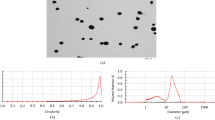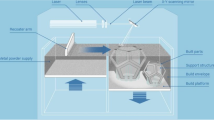Abstract
This work addresses the issues of entrapment of polymer powder and the post-processing powder removal challenges in surface-based lattice structures 3D printed with powder bed-based additive manufacturing (AM) technology. A ventilation design approach has been proposed to enhance the powder removability from the widely researched three-dimensional gyroid and two-dimensional honeycomb lattice structure. The flow characteristics and mechanical behavior of the designed lattices were analyzed using computational fluid dynamics (CFD) and finite element analysis (FEA), respectively, followed by experimental powder flow and compression testing. HP jet fusion 4200® industrial 3D printer was used for printing the lattice structures for experimental validation. The results showed a 65–85% improvement in powder flowability, with a minimum to severe reduction in mechanical strength of different lattice structures. The study can be applied to designing products with multi-functional properties with surface-based lattice structures by employing the principle of design for additive manufacturing and post-processing (DfAM&PP).











Similar content being viewed by others
References
Tofail SAM, Koumoulos EP, Bandyopadhyay A et al (2018) Additive manufacturing: scientific and technological challenges, market uptake and opportunities. Mater Today 21:22–37. https://doi.org/10.1016/j.mattod.2017.07.001
ASTM (2017) ASTM F42/ISO TC 261 develops additive manufacturing standards. ASTM Interational 1–2
Dizon JRC, Espera AH, Chen Q, Advincula RC (2018) Mechanical characterization of 3D-printed polymers. Addit Manuf 20:44–67. https://doi.org/10.1016/j.addma.2017.12.002
Diegel O, Nordin A, Motte D (2019) Post-processing. A practical guide to design for additive manufacturing. Springer Singapore, Singapore, pp 181–207
Wohlers Associates (2021) Post-processing of AM and 3D-printed parts
Dizon JRC, Gache CCL, Cascolan HMS et al (2021) Post-processing of 3D-printed polymers. Technologies 9:61. https://doi.org/10.3390/technologies9030061
Piedra-Cascón W, Krishnamurthy VR, Att W, Revilla-León M (2021) 3D printing parameters, supporting structures, slicing, and post-processing procedures of vat-polymerization additive manufacturing technologies: a narrative review. J Dent 109:103630. https://doi.org/10.1016/j.jdent.2021.103630
Khan HM, Karabulut Y, Kitay O et al (2021) Influence of the post-processing operations on surface integrity of metal components produced by laser powder bed fusion additive manufacturing: a review. Mach Sci Technol 25:118–176. https://doi.org/10.1080/10910344.2020.1855649
Šoškić Z, Monti GL, Montanari S et al (2021) Production cost model of the multi-jet-fusion technology. Proc Inst Mech Eng Part C J Mech Eng Sci 235:1917–1929. https://doi.org/10.1177/0954406219837300
Hasib H, Harrysson OLA, West HA (2015) Powder removal from Ti-6Al-4V cellular structures fabricated via electron beam melting. JOM 67:639–646. https://doi.org/10.1007/s11837-015-1307-x
Hunter LW, Brackett D, Brierley N et al (2020) Assessment of trapped powder removal and inspection strategies for powder bed fusion techniques. Int J Adv Manuf Technol 106:4521–4532. https://doi.org/10.1007/s00170-020-04930-w
Cheah CM, Chua CK, Leong KF, Chua SW (2003) Development of a tissue engineering scaffold structure library for rapid prototyping. Part 1: Investigation and classification. Int J Adv Manuf Technol 21:291–301. https://doi.org/10.1007/s001700300034
Postprocess (2020) Annual additive post-printing survey : trends report 2020 ANNUAL EDITION 2020 INTRODUCTION
Laing PG, Ferguson AB, Hodge ES (1967) Tissue reaction in rabbit muscle exposed to metallic implants. J Biomed Mater Res 1:135–149. https://doi.org/10.1002/jbm.820010113
Verma S, Kumar A, Lin S, Jeng J (2022) A bio-inspired design strategy for easy powder removal in powder-bed based additive manufactured lattice structure. Virtual Phys Prototyp 17:468–488. https://doi.org/10.1080/17452759.2022.2039071
Gibson LJ, Ashby M (1999) Cellular_Solids: structure and properties, 2nd edn. Cambridge University Press
Tancogne-Dejean T, Diamantopoulou M, Gorji MB et al (2018) 3D Plate-lattices: an emerging class of low-density metamaterial exhibiting optimal isotropic stiffness. Adv Mater 30:1–6. https://doi.org/10.1002/adma.201803334
Zhang L, Feih S, Daynes S et al (2018) Energy absorption characteristics of metallic triply periodic minimal surface sheet structures under compressive loading. Addit Manuf 23:505–515. https://doi.org/10.1016/j.addma.2018.08.007
Ashby M (2006) The properties of foams and lattices. Philos Trans R Soc A Math Phys Eng Sci 364:15–30. https://doi.org/10.1098/rsta.2005.1678
Kang D, Park S, Son Y et al (2019) Multi-lattice inner structures for high-strength and light-weight in metal selective laser melting process. Mater Des 175:107786. https://doi.org/10.1016/j.matdes.2019.107786
Bhat C, Kumar A, Jeng J-Y (2021) Effect of atomic tessellations on structural and functional properties of additive manufactured lattice structures. Addit Manuf 47:102326. https://doi.org/10.1016/j.addma.2021.102326
Wang Y, Zhang L, Daynes S et al (2018) Design of graded lattice structure with optimized mesostructures for additive manufacturing. Mater Des 142:114–123. https://doi.org/10.1016/j.matdes.2018.01.011
Kumar A, Collini L, Ursini C, Jeng J-Y (2022) Energy absorption and stiffness of thin and thick-walled closed-cell 3D-printed structures fabricated from a hyperelastic soft polymer. Materials (Basel) 15:2441. https://doi.org/10.3390/ma15072441
Javid F, Liu J, Rafsanjani A et al (2017) On the design of porous structures with enhanced fatigue life. Extrem Mech Lett 16:13–17. https://doi.org/10.1016/j.eml.2017.08.002
Khrapov D, Koptyug A, Manabaev K et al (2020) The impact of post manufacturing treatment of functionally graded Ti6Al4V scaffolds on their surface morphology and mechanical strength. J Mater Res Technol 9:1866–1881. https://doi.org/10.1016/j.jmrt.2019.12.019
Abou-Ali AM, Al-Ketan O, Lee D-W et al (2020) Mechanical behavior of polymeric selective laser sintered ligament and sheet based lattices of triply periodic minimal surface architectures. Mater Des 196:109100. https://doi.org/10.1016/j.matdes.2020.109100
Verma S, Kumar A, Lin S-C, Jeng J-Y (2022) CFD and strength analysis of novel biomimetic lattice structure designed for additive manufacturing and post-processing. Mater Des 224:111375. https://doi.org/10.1016/j.matdes.2022.111375
Funding
This research work is financially supported by the Taiwan High Speed 3D Printing Research Center from the Featured Areas Research Center Program within the framework of the Higher Education Sprout Project by the Ministry of Education (MOE) (grant number 108PO15) in Taiwan.
Author information
Authors and Affiliations
Contributions
All authors contributed to the conception and design of this study. The material preparation, methodology, analysis, data collection, and writing the original draft were performed by Saurav Verma. The project administration, technical guidance, and investigation were performed by Ajeet Kumar. And the idea validation, project supervision, and funding acquisition were performed by Jeng Ywan Jeng. All authors have contributed in commenting and editing of the manuscript. All authors have read and approved the final manuscript.
Corresponding author
Ethics declarations
Competing interests
The authors declare no competing interests.
Additional information
Publisher's Note
Springer Nature remains neutral with regard to jurisdictional claims in published maps and institutional affiliations.
Rights and permissions
Springer Nature or its licensor (e.g. a society or other partner) holds exclusive rights to this article under a publishing agreement with the author(s) or other rightsholder(s); author self-archiving of the accepted manuscript version of this article is solely governed by the terms of such publishing agreement and applicable law.
About this article
Cite this article
Verma, S., Kumar, A. & Jeng, JY. Ventilated surface-based lattice structures designed for polymer powder bed fusion process. Int J Adv Manuf Technol 132, 113–126 (2024). https://doi.org/10.1007/s00170-024-13304-5
Received:
Accepted:
Published:
Issue Date:
DOI: https://doi.org/10.1007/s00170-024-13304-5










